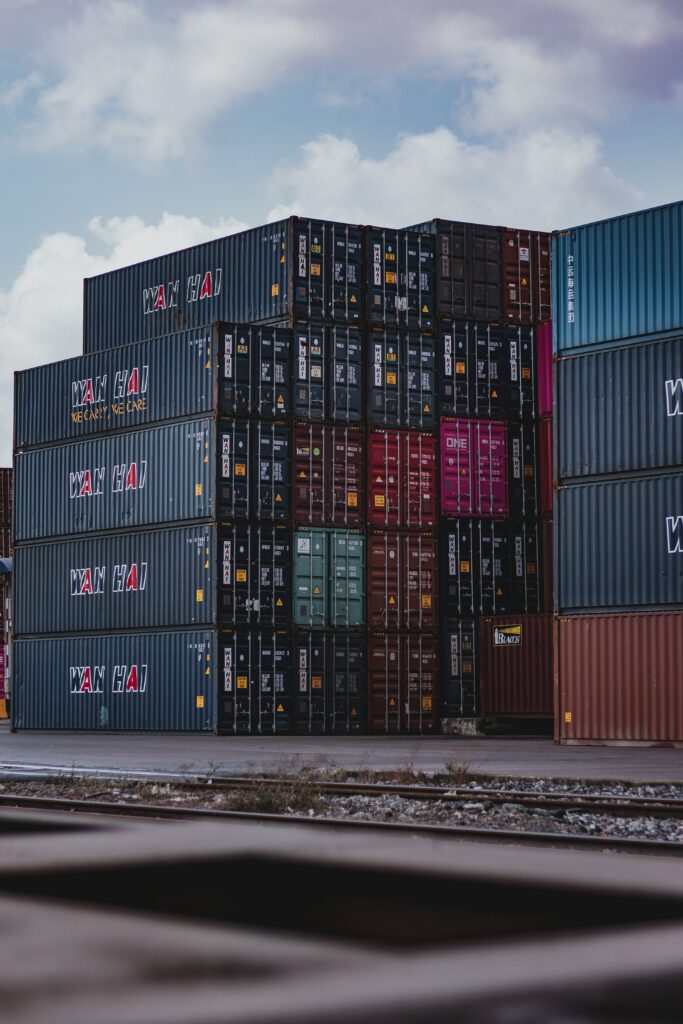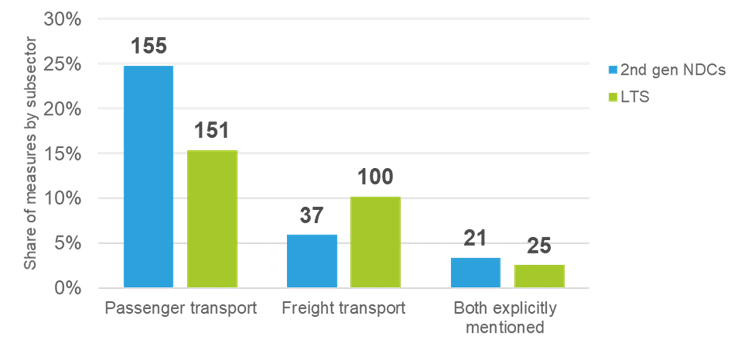
Author: Marion Vieweg
Abating emissions from the transport sector will not be possible without tackling the freight sector. In 2015, the movement of goods caused 42% of all transport greenhouse gas emissions globally. Under current policies, freight emissions are expected to be 22% higher than 2015 by 2050, although they could be 72% less than 2015 with the right policies in place. This clearly shows the urgent need to act. But do we see this reflected in nationally determined contributions (NDCs) and long-term strategies (LTS)?
The short answer is – no!
Only 9.3% of measures in second generation NDCs (i.e. new and updated NDCs) explicitly refer to freight, compared to 25% explicitly mentioning passenger transport. The share in LTS is slightly higher, with 10.3% explicitly referring to freight. Some of the measures that are more general in nature also affect the freight sector, but the lack of explicit mention is an indication of the lack of policy attention we also see in national policies.

Technical solutions for freight vehicles are not quite as clear-cut as for passenger vehicles yet. While electrification will shape the way forward for urban and short- and medium-distance deliveries, solutions for heavy long-haul road freight and shipping are still under debate and mostly still under development.
However, the strong focus on the vehicle technology often distracts from system-based solutions that are well-known and don’t require new technology. When looking at the broader system of how goods are moved rather than at the individual vehicle, large potentials to reduce greenhouse gas emissions become apparent. Very often, those can already be implemented now while vehicle technology development is ongoing.
An increase in efficiency benefits not only to the climate, but also business interests. Despite this win-win situation, only 1.8% of measures in new and updated NDCs contain elements that explicitly address system efficiency in logistics. Current freight systems are highly inefficient. On the one hand, we need to improve the way vehicles are utilised. This includes the improvement of vehicle loading, the reduction of empty running and more efficient routing. Far too many trucks on the road are moving below maximum capacity or even empty, and the frequency of rail service leaves tracks underutilised in many regions.
The efficiency of vehicle utilisation can also be supported by digital technology solutions, such as digital freight marketplaces and route optimisation software. Governmental support to the uptake of such practices needs to be developed in dialogue with logistics companies, cities and regions. Price signals can also help to increase monetary efficiency gains and reward private-sector action. A number of global green freight initiatives provide information and support for the design and implementation of such measures, such as the Global Green Freight Action Plan.
On the other hand, as many goods as possible need to be transported by low-carbon modes, such as rail and waterways. Especially electrified rail systems can help solve some of the challenges encountered in decarbonising long-distance road freight. Of course, rail networks and waterways come with special demands on inter-modality, to ensure that the goods reach their end user. Dense networks and efficient multi-modal logistics chains are necessary. Additional cost and the risk of long waiting times for switching from the long-distance carrier to last-mile delivery currently pose barriers for businesses and customers, often leading to a clear preference for trucks for many.
Only massive investment in the expansion of rail and waterway infrastructure and multi-modal hubs will enable more freight to be moved by rail or on waterways instead of roads. Instead, we still see the largest share of investment going into road expansion in many countries. In China, for example, 85% of total transport infrastructure investments in 2018 were directed to roads, with a more than six-fold increase in road investment over the last decade. In NDCs, we see a clear focus on vehicles, with only 1.9% and 0.3% of measures aiming to expand or improve rail and waterway infrastructure for freight, respectively.
Zero-carbon trucks and ships are still in their infancy, and even with higher levels of efficiency in the overall system, we will still see many combustion engines running freight for decades to come. This makes it essential to ensure that those vehicles are as fuel efficient as possible. In 2019, only 33 countries globally had fuel economy standards or equivalents in place for heavy-duty vehicles. A quick implementation of fuel or greenhouse gas emission standards will reduce the fuel cost of companies and payback periods can be as short as a year, depending on vehicle and fuel cost.
Despite the high cost-efficiency of such standards, they only feature in two of the second generation NDCs and one LTS. The fast implementation of ambitious standards should be complemented with support programmes that help companies to stem the higher upfront cost for vehicles and provide incentives to scrap extremely old and inefficient trucks.
| Box: Green freight in India India’s freight transport sector offers enormous potential for climate mitigation and sustainable economic development by increasing its efficiency, shift of road-based freight to railway and ships and promoting modern technologies. Therefore, the project attempts to introduce appropriate strategies, technical solutions, and approaches to develop competences to coordinate and implement the National Integrated Logistics Plan (NILP). The project advises its partner ministry on setting up coordination and monitoring mechanisms for the NILP. It also supports selected national authorities in the development of climate-friendly standards and regulations as part of the NILP Action Plans. Promising approaches are tested in a selected logistics corridor. For more information on the project see here. |
National commitments submitted to the UNFCCC so far are falling short of delivering any real ambition for the freight sector. However, the Memorandum of Understanding on Zero-Emission Medium- and Heavy-Duty Vehicles launched at COP 26 gives rise to hope. The 15 signatories 1 commit for zero-emission medium and heavy-duty vehicles to reach 30% of sales by 2030 and 100% between 2040 and 2050, facilitating net-zero carbon emissions by 2050. Unfortunately, so far only 8% of global transport sector emissions are covered by the MoU, but it is a step in the right direction and more countries should sign up and collaborate in finding ways on how to best achieve these ambitious goals.
This blog article is part of a series of five blog articles around transport in new and updated NDCs and LTS based on an assessment by GIZ and SLOCAT and funded by the International Climate Initiative (IKI) of the German Federal Ministry for the Environment, Nature Conservation, Nuclear Safety and Consumer Protection. For a comprehensive overview of further aspects of the assessment take a look at our brochure. The blog series follows recommendations for policymakers on how to enhance climate ambition in transport (available here).
Check out other blog articles of the series and stay tuned for more articles to come!
Stay tuned for more blog articles to come!
On 8 February we will look at the role of electric mobility and alternative transport fuels in the new climate policy documents.
Published 25.01.2022
1 13 countries plus Scotland and Wales, as of 24 January 2022
 Source: Pexels, Felix Haumann
Source: Pexels, Felix Haumann